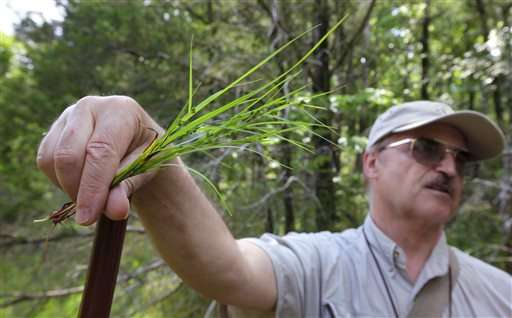Fewer students study botany, more plant collections closing

The teeming plant world could become a virtual mystery in the coming decades as college students increasingly shy away from studying botany and universities across the U.S. shutter their long-standing herbaria.
Since 1988, the number of research universities offering botany degrees has dropped by half, according to National Science Foundation research funding statistics. And the National Center for Education Statistics reports that fewer than 400 undergraduate, graduate and doctoral botany degrees were awarded in 2012. Educators say that's because students are being pushed into more modern, technology-related majors.
Current botanists fear that will lead to a dearth of people able to teach about, identify and use plants, which could harm conservation efforts and even the ability to develop alternate fuels and important medicines. At the same time, universities and states struggling under budget cuts are closing the sometimes-expensive task of maintaining herbaria— collections of plant species that botanists can reference or use for genetic material.
"We aren't going to understand what we have in the world. By some estimates only 20 percent of the (plant and animal) species in the world have been identified," said Joe Miller, a program officer at the National Science Foundation's Division of Environmental Biology.
In a clearing on the side of a rural Arkansas highway, about a dozen researchers scoured the rocky glade for a threatened annual called the Missouri bladderpod, which blooms with clusters of small yellow flowers. Only 75 populations of the threatened species exist in the world, and all are close enough to urban centers to be in danger, Arkansas Natural Heritage Commission botanist Theo Witsell said.
The 39-year-old, carrying a small shovel and a handful of large plastic bags, plucked a few purple flowering plants from the ground by the root.
"I think one of the things that's happening in this field of study is there aren't a lot of open jobs," Witsell said. "But as people get older and they retire, you then have fewer people who are qualified for those jobs."
Witsell hopes to conserve some of the glades, where he said scientists are still finding new species of plants. That's where botanists' skills are irreplaceable, Miller said.
"If we are able to name a plant, then we understand its biology," Miller said. "If we understand its biology, then we can use the comparative method to understand and predict how it could be used."
For example, Quinine is a malaria treatment that occurs naturally in cinchona trees. He said if botanists identify plants with similar taxonomies that react similarly to their surroundings, plant biologists could do genetic research to find medical uses.
Herbaria are a major reference source for botanists, but increasingly, such repositories are dwindling as several states and universities have closed or consolidated their collections, including the University of Iowa and the University of Nebraska State Museum. Researchers acknowledge the bulky collections of plant specimens that are mounted, dried, dated and tagged with pivotal information can be hard to maintain. They require temperature and moisture control and space for the preparation process.
The University of Missouri announced May 18 that it would donate its more than 200,000 plant specimens to the Missouri Botanical Garden in St. Louis.
"The facility on campus that was housing them, it outlived its lifespan," said Jordan Yount, a spokesman for the university's College of Arts and Science. "Regulating the humidity and temperature was critical and getting to be a problem. And we reached a point where we had to decide, do we spend a lot of money renovating this facility or find another home for the collection."
From his 14th-floor office in downtown Little Rock, Witsell is fighting the trend. After the University of Arkansas at Fayetteville herbarium narrowly escaped closure in 2003 and the University of Arkansas at Little Rock closed its collection a few years later, he decided the commission needed its own.
A handful of commission staff and Witsell have combed the state over the past 12 years to find, collect and preserve more than 70,000 native plant species. The commission's herbarium is now the most actively growing in Arkansas.
"This is the physical record of the plant life of the planet, of this state," he said. "You can't get all of the information from a photograph."
© 2015 The Associated Press. All rights reserved.

















